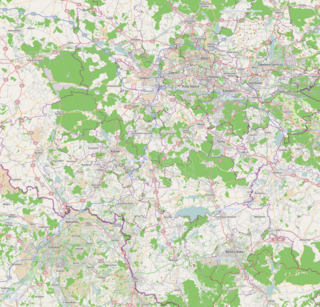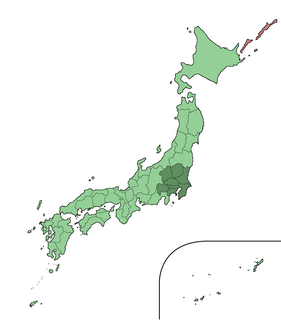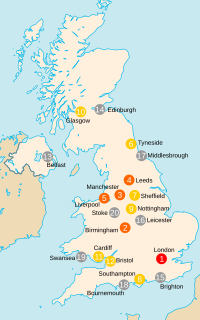Related Research Articles

A metropolitan area or metro is a region consisting of a densely populated urban core and its less-populated surrounding territories under the same administrative division, sharing industry, infrastructure and housing. A metro area usually comprises multiple jurisdictions and municipalities: neighborhoods, townships, boroughs, cities, towns, exurbs, suburbs, counties, districts, states, and even nations like the eurodistricts. As social, economic and political institutions have changed, metropolitan areas have become key economic and political regions.

A conurbation is a region comprising a number of metropolises, cities, large towns, and other urban areas that, through population growth and physical expansion, have merged to form one continuous urban or industrially developed area. In most cases, a conurbation is a polycentric urbanised area, in which transportation has developed to link areas to create a single urban labour market or travel to work area.

The Upper Silesian metropolitan area is a metropolitan area in southern Poland and northeast Czech Republic, centered on the cities of Katowice and Ostrava in Silesia and has around 5 million inhabitans. Located in the three administrative units : mainly Silesian Voivodeship, a small western part of Lesser Poland Voivodeship and a small east part of Moravian-Silesian Region.

The Greater Tokyo Area is the most populous metropolitan area in the world, consisting of the Kantō region of Japan as well as the prefecture of Yamanashi of the neighboring Chūbu region. In Japanese, it is referred to by various terms, one of the most common being Capital Region.

An aire urbaine is an INSEE statistical concept describing a core of urban development and the extent of its commuter activity.

An urban area, or built-up area, is a human settlement with a high population density and infrastructure of built environment. Urban areas are created through urbanization and are categorized by urban morphology as cities, towns, conurbations or suburbs. In urbanism, the term contrasts to rural areas such as villages and hamlets; in urban sociology or urban anthropology it contrasts with natural environment. The creation of early predecessors of urban areas during the urban revolution led to the creation of human civilization with modern urban planning, which along with other human activities such as exploitation of natural resources led to a human impact on the environment. "Agglomeration effects" are in the list of the main consequences of increased rates of firm creation since. This is due to conditions created by a greater level of industrial activity in a given region. However, a favorable environment for human capital development would also be generated simultaneously.
An urban area or tätort in Sweden has a minimum of 200 inhabitants and may be a city, town or larger village. It is a purely statistical concept, not defined by any municipal or county boundaries. Larger urban areas synonymous with cities or towns for statistical purposes have a minimum of 10,000 inhabitants. The same statistical definition is also used for urban areas in the other Nordic countries.

The North Region or Northern Portugal is the most populous region in Portugal, ahead of Lisboa, and the third most extensive by area. The region has 3,576,205 inhabitants according to the 2017 census, and its area is 21,278 kilometres (13,222 mi) with a density of 173 inhabitants per square kilometre. It is one of five regions of Mainland Portugal. Its main population center is the urban area of Porto, with about one million inhabitants; it includes a larger political metropolitan region with 1.8 million, and an urban-metropolitan agglomeration with 2.99 million inhabitants, including Porto and a number of urban areas in Northwestern Portugal, like Braga and Guimarães. The Commission of Regional Coordination of the North (CCDR-N) is the agency that coordinates environmental policies, land-use planning, cities and the overall development of this region, supporting local governments and associations.
The larger urban zone (LUZ), or functional urban area (FUA), is a measure of the population and expanse of metropolitan areas in Europe. It consists of a city and its commuting zone.
The metropolitan areas of Mexico have been traditionally defined as the group of municipalities that heavily interact with each other, usually around a core city. The phenomenon of metropolization in Mexico is relatively recent, starting in the 1940's, and due to the accelerated level of urbanization in the country, the definition of a metropolitan area is reviewed periodically by the Mexican population and census authorities.

The Copenhagen metropolitan area or Metropolitan Copenhagen is a large commuter belt surrounding Copenhagen, the capital of Denmark. It includes Copenhagen Municipality, Frederiksberg and surrounding municipalities stretching westward across Zealand. It has a densely-populated core surrounded by suburban settlements.

Urbanization in China increased in speed following the initiation of the reform and opening policy. As of 2020, 60.6% of the total population lived in urban areas, a dramatic increase from 17.92% in 1978.

A metropolitan area is generally defined as consisting of an urban area, conurbation or agglomeration, together with the surrounding area to which it is closely economically and socially integrated through commuting.
References
- ↑ OECD - FUNCTIONAL URBAN AREAS IN OECD COUNTRIES: HUNGARY
- ↑ OECD - FUNCTIONAL URBAN AREAS IN OECD COUNTRIES: HUNGARY
- ↑ OECD - FUNCTIONAL URBAN AREAS IN OECD COUNTRIES: HUNGARY
- ↑ OECD - FUNCTIONAL URBAN AREAS IN OECD COUNTRIES: HUNGARY
- ↑ Population on 1 January by age groups and sex - functional urban areas, 2018 - Eurostat
